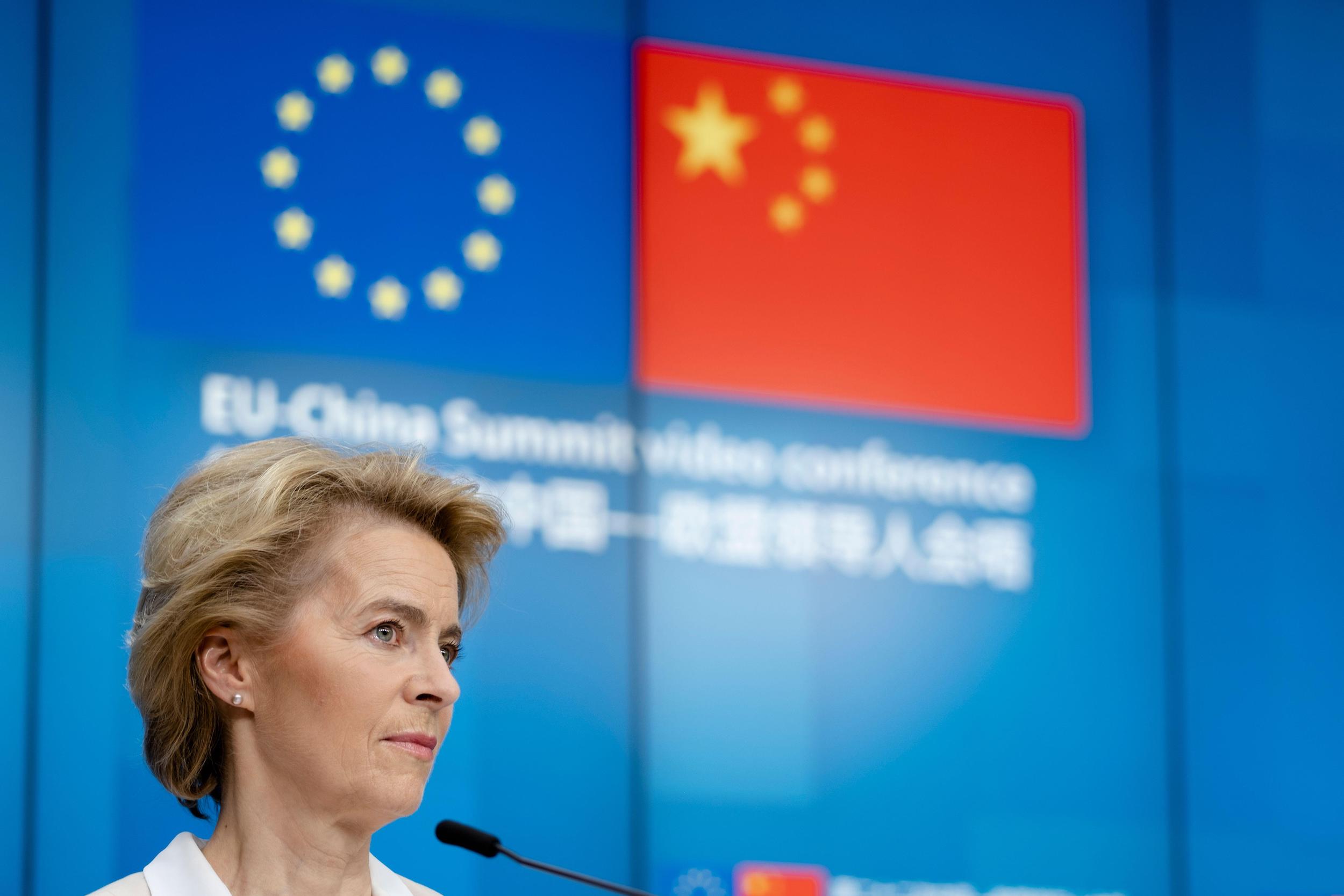The two can still achieve positive results for the global environment, says Dimitri de Boer, team leader of the EU-China environment project

Ursula von der Leyen, president of the EU Commission, at an EU–China summit video conference (Image: Alamy)
With the global economy devastated by Covid-19 and US–China tensions escalating day by day, the world is increasingly looking at the EU–China relationship for answers to the pressing challenges of economic recovery, climate change and general environmental degradation.

As two of the world’s most important economies, both the EU and China have rolled out major economic stimulus packages. Both also remain openly committed to multilateral environmental mechanisms such as the Paris Agreement and the United Nations Convention on Biological Diversity (CBD). However, the postponement of September’s highly anticipated EU–China leaders’ summit in Leipzig, Germany, sapped hopes for a breakthrough climate deal between the two sides and made some question the prospects for future cooperation.
As a facilitator of EU–China environmental policy exchanges based in Beijing, Dimitri de Boer explains to China Dialogue how bilateral collaborations between the two sides are still moving forward on the operational level and beyond.
China Dialogue: How has Covid-19 affected EU–China environment collaboration? Did exchanges happen during this difficult period?
Dimitri de Boer: The EU had just received a very strong environmental mandate right as Covid-19 started to hit. The EU’s executive vice president, Frans Timmermans, was very keen to reach out to China to strengthen the EU–China environmental relationship, particularly on issues like climate change and the biodiversity agenda.
He was planning to visit China in February but that got cancelled because of Covid-19. What has actually happened since then is that he made a few virtual calls with his Chinese counterparts, Vice Premier Han Zheng and the new environment minister, Huang Runqiu. (Normally he might have made one visit in a two-year period.) He also provided inputs to the policy recommendations made by the China Council for International Cooperation on Environment and Development (CCICED), an international advisory body to the Chinese State Council. I’m seeing a very proactive attitude from both sides to engage on environmental topics.
What are some of the priority issues for the EU in those exchanges?
The most important topic is probably green economic recovery. The EU has rolled out an ambitious Green Deal. We are getting very positive signals from countries like Germany, France and the EU as a whole in terms of ensuring that the stimulus packages in response to the pandemic are “green”. For example, a certain share of the stimulus packages is earmarked for climate action and for green sectors such as electric mobility, building renovation and the hydrogen economy.
While China doesn’t appear to be rolling out some sort of a “green stimulus plan”, it doesn’t want economic recovery to come at the cost of the environment. Importantly, China is currently preparing the 14th Five Year Plan, which will direct government spending priorities, industrial restructuring and the energy mix over the next five years (2021-2025). China can exchange with the EU on how to stimulate green sectors and put in provisions to avoid excessive carbon lock-in to sectors that are holding back the green transition.
The practice of setting longer-term targets is also an area of valuable EU–China exchange. The Five Year Plan covers a five-year period, whereas the Green Deal sets targets for 2030 to mid-century. Setting those long-term targets is very helpful for industry as they make investment decisions that will be active for the next 20-50 years.
Have you seen any appetite from the Chinese side on green economic recovery?
I have seen several indications. Green economic recovery is the number one topic in CCICED’s policy recommendations for this year, which indicates appetite from the State Council. On the more operational level, we had a few webinars under the EU–China environment project on the EU Green Deal and green economic recovery, which were initiated by the Chinese side. There is also interest in linking China’s Belt and Road investments with green economic recovery in partner countries.
As 2020 began, there were high hopes inside the EU for a high level EU–China climate deal at the September Leipzig leaders’ summit. Now that the summit has been postponed because of Covid-19, what prospects are there for EU–China climate cooperation?
The Leipzig summit had an unfortunate timing in that September was actually a bit early for China to make any real commitments when it comes to climate change. The 14th Five Year Plan is still being elaborated, and China is supposed to provide an updated Nationally Determined Contribution (NDC) under the Paris Agreement towards the end of this year. It’s possible that the delay of the leaders’ summit to November or December could provide China a little bit more time to figure out what sort of an increased ambition it is willing to take on for its updated NDC. Knowing the outcome of the US presidential election in November also helps. I have some confidence that there will be an increased ambition from China. And maybe this EU–China summit will help China catalyse its thinking.
Will the EU’s consideration to impose a carbon border tax complicate the relationship?
It’s a bold move by Europe that could go both ways.
If China accepts that Europe is going to proceed with the border adjustment and then quickly steps up its own carbon market development, then it would be in a position to argue for exemption because the carbon price is already reflected in the goods. That would be the positive scenario.
The negative scenario would be that Europe and China start their own trade war, where China retaliates with tariffs on European imports for example. Then we go into a vicious cycle. I think now we have an opportunity to start that dialogue about how to make the carbon border adjustment work, but it won’t be easy. What carbon price should Chinese companies pay domestically to warrant exemption from EU border adjustments, and how does that relate to the concept of “common but differentiated responsibilities”?
You also mentioned biodiversity as high on the agenda of EU–China environment collaboration this year. Has there been any progress during the difficult period of the pandemic?
Exchanges on biodiversity in the run-up to the Kunming CBD COP15 [now postponed to May 2021] have been ongoing throughout the Covid-19 period. We had two informal workshops for biodiversity negotiators from both sides, one on the technical issue of access and benefit sharing (ABS), and the other on broader subjects. We still have some way to go for all the members of the CBD to get together and form a common position, so having these dialogues between some of the more ambitious blocs is extremely helpful. Topics like targets, mechanisms to strengthen implementation, resource mobilisation and how the COP should be organised are all being discussed.
How would you describe EU expectations for the Kunming COP15?
The EU has very high expectations. And it also has high domestic pressure to achieve something. The dynamic I’m seeing is that the EU is wanting “ambitious, ambitious, ambitious” and the Chinese side is saying “realistic, realistic, realistic”, as it doesn’t want to end up in 2030 and see the Kunming targets not achieved. China also needs to make sure that the other parties are really willing to embrace the new framework, particularly developing countries with concerns for financing and sharing of burdens.
As part of its Green Deal, the EU is proposing ambitious new regulation to ensure that imports become deforestation-free. How would this affect China, as a major processor and exporter of timber and food products?
It’s similar to the carbon border adjustment question. Europe wants to further raise the level of scrutiny on the nature impact of its imports. That could definitely make it harder for Chinese producers to sell certain goods in Europe. The Chinese government is very quickly developing its thinking on commodity-driven deforestation. Whereas perhaps a year or two ago I heard very few people talking about this, CCICED started a special policy study on it in 2019, which signals interest in the government to look into the issue.
Since then I have also heard from officials at the Ministry of Commerce and the Ministry of Foreign Affairs gradually gaining interest in this question: how could government play a role in strengthening traceability and perhaps apply some sort of due diligence requirements? The government’s position so far has been that this should be primarily sector-driven and voluntary. But as a lot of the state-owned enterprises start looking for guidance, government is coming around to the idea that perhaps it also needs to investigate its options.
There has long been talks of timber import regulations. The new Forest Law of 2019 does have a legality requirement, but it’s not so clear yet whether it applies to imports. If further implementing regulations could clarify that, it will set a precedent for other commodities. The fact that Europe has already signalled its intention to move ahead with this will have a stimulating effect on China. Similar to the carbon border adjustment, it could go both ways. The Chinese government could either argue that the EU is imposing unfair trade restrictions, or it could proceed by developing its own legality strategy. If it does, that could set a completely new playing field for the whole world. There is great value in having that dialogue and achieving some alignment between the EU and China.
Does EU–China green cooperation have implications beyond the environment?
With US–China relations being so weak right now, it is extremely valuable that the EU and China continue to cooperate on these global environmental challenges, like climate change and loss of nature. The importance of this cooperation also goes beyond the environment – it provides some much needed positive momentum in global geopolitics.












Đăng nhận xét